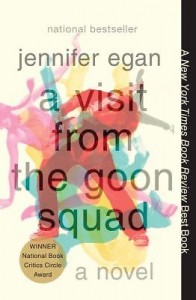 I’m a little late to Egan’s party but, considering she only received notoriety with the publication of A Visit From The Goon Squad in 2010, when she was already in her late forties, perhaps so is she. However, given its status atop bestseller lists everywhere, and the National Books Critics Circle Award and Pulitzer Prize wins, she has made one hell of an entrance.
I’m a little late to Egan’s party but, considering she only received notoriety with the publication of A Visit From The Goon Squad in 2010, when she was already in her late forties, perhaps so is she. However, given its status atop bestseller lists everywhere, and the National Books Critics Circle Award and Pulitzer Prize wins, she has made one hell of an entrance.
A Visit From The Goon Squad is difficult to classify. Its cast of characters are haggard musicians or music industry employees who, past their prime, are in the hangover stage of life, forced to contemplate where all the time went. And though, technically, two characters are given primacy – Sasha, a kleptomaniac runaway, and Benny Salazar, the wealthy record executive enamored of her – the book is so short (320 odd pages, including some 80 pages given to a Powerpoint presentation, of which more later) and the cast of characters so large that this could equally be considered a collection of short stories taking place in the same narrative world.
Egan named both Marcel Proust and The Sopranos as major inspirations, but the influence of both is evident only at the level of design. Proust bequeaths the non-linear narrative and The Sopranos’ tendency to give even its minor characters fleshed out backstories is impressively recreated by Egan’s plotting. Like Proust, Egan is obsessed with time and memory, and she expands her narrative to such an extent that almost every character is presented from childhood to middle age or later. With her most central characters, this is a cleverly executed conceit, one that forces us to confront the changes time has wrought in tandem with her reminiscing characters; with the supporting cast, however, entire lives are divulged in single paragraphs, which often feels gimmicky and ineffective.
When I first picked up the novel and flipped through its pages, I was dismayed by the appearance of what is essentially a Powerpoint presentation taking up a third of the book’s length. In my experience, rarely are such innovations effective, and the novel already seemed too short for her grand ambitions. I was all the more pleased to discover that this section is among the novel’s most forceful, playfully revealing important details even as it justifies its own use.
For all the cynicism and despair contained in this novel, it manages to be by turns wickedly funny and heartbreakingly poignant.